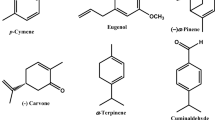Abstract
The insect growth regulatory, antifeedant, adult inhibitory and egg laying capacity of essential oils from V. rosea and C. lanceolatus alone and their combinations at different ratios were evaluated against the third instar larvae of H. armigera by leaf residue method. It has been recorded that highest growth regulatory (GI50) at 3 and 7 DAT, antifeedant (AI50) at 24 h and adult inhibitory activities (I50) were observed at 1:1 mixture and their corresponding values were 4808, 3562, 4088 and 3046 ppm respectively. Similarly, the lowest egg production was also observed from 1:1 combination followed by 1:3 and 3:1. Among the two plants tested, V. rosea showed higher growth inhibitory, antifeedant and adult inhibitory activities and lowest fecundity than C. lanceolatus.

Similar content being viewed by others
References
Commonwealth Agricultural Bureau (CABI)/European and Mediterranean Plant Protection Organization (EPPO) (1998) Helicoverpa armigera: distribution maps of quarantine pests for Europe No. 77. Commonwealth Agricultural Bureau International, Wellingford
ICRISAT (2003) Annual Report, 2002–2003 ICRISAT. ICRISAT, Patencheru, Andhra Pradesh, India
Jackson RD, King EG, and Knippling EF (1989) Heliothis: need for international collaborative research on biological control. In: Proceedings of the workshop on biological control of Heliothis: increasing the effectiveness of natural enemies, New Delhi, India, 11–15 November 1989
Singh RO (2000) Botanicals in pest management: an ecological prospective. In: Dhaliwal GS, Singh B (eds) Pesticides and environment. Commonwealth Publishers, New Delhi, pp 56–112
Raheza AK (1998) Crop protection chemicals in IPM. Pestology 22(4):6–11
Parmar BS, Singh RP (1993) Neem in agriculture. Indian Agricultural Research Institute, New Delhi, p 85
Rajendran D, Gopalan M (1980) Juvenile hormone like activity of certain plant extracts on Dysdercus cingulator Fab. Indian J Agric Sci 50(10):781–784
Kaushik N (1999) Larval development and survival of gram pod borer (Helicoverpa armigera) on diet containing eucalyptus and callistemon leaf extracts. In: Abstract presented in X/V International Plant Protection Congress, Jerusalem, 25–29 July 1999
Kathuria V, Kaushik N (2005) Feeding inhibition of Helicoverpa armigera (Hubner) by Eucalyptus camaldulensis and Tylophora indica extracts. Insect Sci 12(4):249–254
Abbott WS (1925) A method of computing effectiveness of an insecticide. J Econ Entomol 18:265–267
Gomez KA, Gomez AA (1984) Statistical procedures for agricultural research. Wiley, New York, p 680
Jaiswal AK, Srivastava US (1993) Plant as a natural source of insect growth regulator. Trop Sci 33:411–416
Landis DA, Gould F (1988) Screening for phyto-protectants to guard corn seeds/seedlings from southern corn rootworm feeding injury. J Entomol Sci 23:201–211
Halder J, Srivastava C, Dhingra S, Dureja P, Tanwar RS (2009) Antifeedant activity of methanolic extracts of Vinca rosea and Callistemon lanceolatus alone and their mixtures against Gram pod borer, Helicoverpa armigera Hub. Ann Plant Prot Sci 17(2):496–497
Sharma SS, Gill K, Malik MS, Malik OP (2001) Insecticidal, antifeedant and growth inhibitory activities of essential oils of some medicinal plants. J Med Arom Plants 22/23(4A/1A):373–377
Ahmad M (2007) Insecticide resistance mechanisms and their management in Helicoverpa armigera (Hubner)—a review. J Agric Res 45:319–335
Kumar N, Khader JMA, Ragaswami P, and Irulappan I (2004) Introduction to species, plantation, plantation crops, medicinal and aromatic plants. Oxford and IBH Publishing Co, Pvt Ltd., New Delhi, pp 25–26
Nyein MM, Win NY, Myint W, Thein AA, Htwe MM, Win-Win-Maw WW, Than A (1999) Plants possessing antibacterial activity. Myanmar Health Sci Res J 11(1/3):26–32
Kshirsagar CR, Jadhav AC, Nimbalkar RD (2004) In-vitro evaluation of plant extracts against Rhizoctonia solani causing root rot of cotton. J Maharashtra Agric Univ 29(3):334–335
Alagumalai K, Hepsyba CSS, Ramaraj P (1991) Effect of leaf extract of Vinca rosea on the host plant cowpea infected with Meloidogyne incognita. Curr Nematol 2(2):109–111
Chowdhary H, Walia S, Dhingra S (2001) Bio-efficacy of azadirachtin, turmeric oil and their mixtures against Bihar hairy caterpillar, Spilosoma obliqua (Walker). Pestic Res J 13(2):165–172
Author information
Authors and Affiliations
Corresponding author
Rights and permissions
About this article
Cite this article
Halder, J., Srivastava, C., Dhingra, S. et al. Effect of Essential Oils on Feeding, Survival, Growth and Development of Third Instar Larvae of Helicoverpa armigera Hubner. Natl. Acad. Sci. Lett. 35, 271–276 (2012). https://doi.org/10.1007/s40009-012-0043-9
Received:
Accepted:
Published:
Issue Date:
DOI: https://doi.org/10.1007/s40009-012-0043-9




